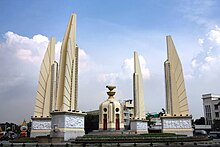Politics and government
Main articles: Politics of Thailand, Constitutions of Thailand, Law of Thailand and Government of Thailand
The politics of Thailand is currently conducted within the framework of a constitutional monarchy, whereby the Prime Minister is the head of government and a hereditary monarch is head of state. The judiciary is supposed to be independent of the executive and the legislative branches, although judicial rulings are suspected of being based on political considerations rather than on existing law.[31]
Constitutional history
Since the political reform of the absolute monarchy in 1932, Thailand has had 19 constitutions and charters.[32][33] Throughout this time, the form of government has ranged from military dictatorship to electoral democracy, but all governments have acknowledged a hereditary monarch as the head of state.[34][35]
28 June 1932
Prior to 1932, the Kingdom of Siam did not possess a legislature, as all legislative powers were vested in the person of the monarch. This had been the case since the foundation of the Sukhothai Kingdom in the 12th century as the king was seen as a "Dharmaraja" or "king who rules in accordance with Dharma", (the Buddhist law of righteousness). However, on 24 June 1932 a group of civilians and military officers, calling themselves the Khana Ratsadon (or People's Party) carried out a bloodless revolution in which the 150 years of absolute rule of the Chakri Dynasty ended. In its stead the group advocated a constitutional form of monarchy with an elected legislature.
The "Draft Constitution" of 1932 signed by King Prajadhipok created Thailand's first legislature, a People's Assembly with 70 appointed members. The assembly met for the first time on 28 June 1932, in the Ananta Samakhom Throne Hall. The Khana Ratsadon decided that the people were not yet ready for an elected assembly. They later changed their minds. By the time the "permanent" constitution came into force in December of that year, elections were scheduled for 15 November 1933. The new constitution changed the composition of the assembly to 78 directly elected and 78 appointed (by the Khana Ratsadon), together totalling 156 member


0 comments:
Post a Comment